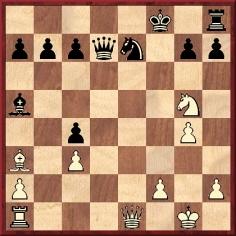Chess
Notes
|
| First column | << previous | Archives [47] | next >> | Current column |
5598. Then and now
A vast disparity between the way a chessplayer was regarded immediately after his death and the manner in which history has viewed him occurs in the case of Frederick L. Slous. Today, he is more or less forgotten, yet the following appeared in his obituary, written by William Wayte, on pages 395-396 of the September 1892 BCM:
‘Mr Slous’ culminating period as a player seems to have been about the years 1835-40, when between the death of [McDonnell] and the rise of Staunton to the championship he shared with George Walker the primacy of English chess. The latter, writing in 1844, says (Preface to Chess Studies, page xi): “Had Mr Slous continued to practise chess, it is highly probable he would have held the ground now occupied by Mr Staunton.”’
Edward Freeborough used almost the same words as Wayte on page ix of his Introduction to a new edition (London, 1893) of Walker’s book. Regarding Slous he stated:
‘In the interval between the death of [McDonnell] and the rise of Staunton, he held, with his friend George Walker, the primacy of English chess.’
5599. Colman

Olimpiu G. Urcan (Singapore) submits a game which he obtained too late for inclusion in his book Surviving Changi. E.E. Colman: A Chess Biography (Singapore, 2007):
Eugene Ernest Colman – Fred W. AllenLondon League, Wimbledon v Athenaeum, 1953
French Defence
1 e4 e6 2 d4 d5 3 Nc3 Bb4 4 e5 c5 5 a3 Bxc3+ 6 bxc3 Ne7 7 h4 Qa5 8 Bd2 Qa4 9 Nf3 Nbc6 10 h5 cxd4 11 Bd3 Bd7 12 h6 g6 13 Kf1 dxc3 14 Bxc3 Na5 15 Rh4 Nc4 16 Bxc4 dxc4 17 Bb4 Nf5 18 Rh3 a5 19 Bd6 Qc6 20 Ng5 Nxd6 21 exd6 f6 22 Qd4 e5

23 Re3 O-O 24 Rxe5 Bh3 25 Rd5 Bd7 26 Rc5 Qa6 27 Qd5+ Kh8 28 Nf7+ Resigns.
Source: The Field, 29 January 1953, page 175.
5600. Bogoljubow and Heaven
Page 229 of Kings, Commoners and Knaves referred to Alekhine’s alleged description of a dream in which chess masters were banned from Heaven but Bogoljubow gained entry because ‘he only thinks he’s a master’. See, for instance, pages 21-22 of The Bright Side of Chess by Irving Chernev (Philadelphia, 1948). We pointed out that the same yarn had appeared on page 6 of the July 1898 American Chess Magazine, and that item is reproduced below:

When were Alekhine and Bogoljubow introduced into the story?
5601. Smoking anecdote
An addition to our feature article A Nimzowitsch Story (regarding smoking and the threat being stronger than the execution): on page 97 of Caïssas Weltreich by Max Euwe and Bob Spaak (Berlin-Frohnau, 1956) the would-be smoker was Bogoljubow:
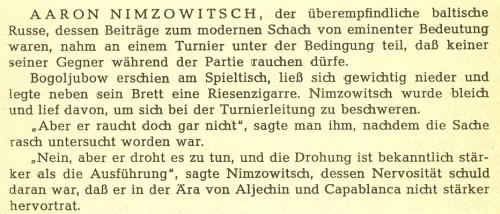
5602. Who? (C.N. 5593)
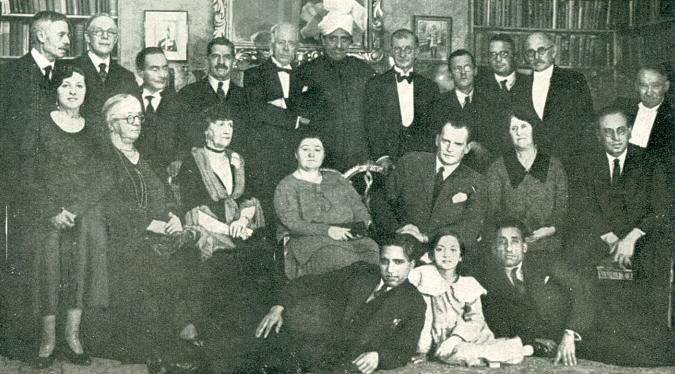
Centre background:
Colonel Nawab Sir Umar Hayat Khan
Back row (left to right): C.D. Locock, R.H.S.
Stevenson, P.W. Sergeant, C. Wreford Brown, Sir
Ernest Graham-Little, M.P., R.C. Griffith, F.D.
Yates, J. du Mont, A. Rutherford, J.B. Whieldon
Next row: Miss Joseph, Mrs Latham, Mrs Arthur
Rawson, V. Menchik, A. Alekhine, Mrs Stevenson, J.A.
Seitz.
Foreground: S. Basalvi, Aziz, Mir Sultan Khan.
The photograph came from the February 1932 BCM, and the magazine’s key has been given. Page 71 explained the occasion:
‘Colonel Sir Umar Hayat Khan arranged one or two receptions at his residence in honour of Dr Alekhine, the champion of the world. On each evening a dinner followed, characterized by all Sir Umar’s well-known hospitality. On 15 December after full justice had been done to the repast, speeches were made by Sir Ernest Graham-Little, MP, J. Whieldon, C. Wreford Brown and R.C. Griffith; Miss Vera Menchik and Dr Alekhine himself responded to the good wishes and thanks accorded them by the company.
The group photo we give as frontispiece was taken by Malik Ghulam Mohammed Khan, one of the most trusty of Sir Umar’s entourage and a warrior of great distinction. The small photo hanging on the wall to the right of the mirror (behind R.C. Griffith and F.D. Yates) shows Sir Umar in his official robes as Herald of the Princes at the great Durbar.’
5603. Staunton and Shakespeare (C.N.s 5506 & 5516)
From Richard Allen (Cambridge, England):
‘The commentary on this subject in C.N. 5516 indicated that while Howard Staunton was a Shakespearean scholar and editor of considerable learning and distinction in his own time, his contribution to this field is only briefly and occasionally recognized today. This is unsurprising, given that Shakespeare studies have become a mass global industry in the modern age. Indeed, one aspect of this development, large collaborative projects supported by prestigious institutions, was already under way in Staunton’s own day. His three-volume edition of Shakespeare’s plays (1858) may have earned him £1,000 but it was a labour of love on the part of a self-taught, unaffiliated amateur. It nevertheless won plaudits for its careful and judicious collation of available texts, as well as for other virtues to which I shall return. Unluckily, however, it was rather overshadowed by the appearance only five years later of The Cambridge Shakespeare (1863-66), edited by W.G. Clark, J. Glover and W.A. Wright. This publication, according to J. Isaacs on pages 305-324 of Shakespearian Scholarship, A Companion to Shakespeare Studies by H. Granville-Barker and G.B. Harrison (Cambridge, 1934), “was the great landmark [in Shakespearean scholarship] of the mid-century ... Its rigorous system of collation was facilitated by [Edward] Capell’s superb bequest of quartos to Trinity College’ (page 314). Two further landmarks of collaborative scholarship, J.J. Furness’s New Variorum Edition and the foundation by F.J. Furnivall (“a team-leader”, according to page 315 of Isaacs’ work) of the New Shakspere [sic] Society, followed in 1871 and 1872 respectively. By comparison with these monumental enterprises, Staunton’s achievements must already have appeared somewhat modest by the time he died in 1874.
That, however, is by no means the whole story. Both The Cambridge Shakespeare and Furness’s Variorum were produced by academic specialists for an academic audience; they were tomes to be consulted mainly in university libraries. Staunton’s edition, by contrast, was produced for the general public, first appearing – like a Dickens novel of the same period – in shilling monthly parts. And again like a Dickens novel, only more so, it contained an abundance of distinctive illustrations; there were some 831 sketches by John Gilbert, all engraved by the Dalziel brothers, making Staunton’s edition, according to Peter Holland – see page 65 of volume one of Performing Shakespeare in Print: Narrative in Nineteenth-Century Illustrated Shakespeares, Victorian Shakespeare by G. Marshall and A. Poole (London, 2003) – “the most popular of mid-nineteenth-century illustrated Shakespeares”. The combination of popular appeal and editorial standards that were still acceptably high accounts for its twentieth-century reprint (referred to in C.N. 5516), which remained in print until the early 1990s – “an extraordinary longevity for any Shakespeare edition”, as Holland remarks (volume one, page 67).
There were many illustrated Shakespeares published in the nineteenth century, but in even some of the more notable, such as Charles Knight’s National Edition of 1851, the pictures tend to be undramatic and de-contextualized. In Staunton’s edition, on the other hand, Gilbert’s prodigiously numerous sketches are embedded in the text, providing dramatic vignettes from various distances and perspectives, and foregrounding character. Thus, argues Holland, was “created a dramatic narrative of performance, as close an interconnection between illustrations and the performed text ... as the century could ever have hoped to achieve” (Marshall and Poole, volume one, page 71).
While naturally keen to represent Gilbert as “the powerhouse for the edition” (Marshall and Poole, volume one, page 68), Holland acknowledges Staunton’s “decent and honourable” editing (page 68) and notes that a few of his emendations have retained acceptance among modern editors. The tribute is very much to the point but perhaps understates Staunton’s achievement. The main reason for the small number of emendations retained today is that Staunton actually proposed only a few. This was in keeping with the deliberate modesty and moderation of his whole editorial approach, in which a wide range of available readings has been considered but the oldest (quarto) ones usually adopted unless there is a strong case against. Staunton’s methods need to be seen in the context of the sensational forgeries perpetrated by a leading Shakespearean of the day, J. Payne Collier. In 1853, Collier published Notes and Emendations to the Text of Shakespeare’s Plays, in which he listed marginal annotations in a seventeenth-century hand purportedly discovered in a copy of the Second Folio he had bought in a bookshop. The authenticity of this discovery was soon questioned, but the document and numerous others that Collier claimed to have found were not conclusively proved to be forgeries until 1859. In a detailed account of this shocking case in the Preface to the 1860 edition of his Shakespeare, Staunton states that he himself instigated the scrutiny of the fabricated documents by Sir Frederic Madden, N.E. Hamilton, and other professional “paleographers” at the British Museum; he was prompted, he says, by a sense of responsibility to have the issue determined before his own editorial project saw the light of day. The investigation took longer than anticipated because of Collier’s obstructiveness, but it is clear that Staunton’s commitment to “decent and honourable” editing was reinforced by Collier’s gross transgression of such standards. Staunton’s other major publication in the field, Memorials of Shakespeare (1864), a collection of photolithographic facsimiles of extant documents such as the dramatist’s will and the indentures of conveyance and mortgage of his house, can be seen as similarly motivated by a desire to help restore the values of fidelity and authenticity to popular Shakespeare scholarship.
The essay on Staunton on pages 319-321 of volume 52 of the new Dictionary of National Biography by H.C.G. Matthew and Brian Harrison (Oxford, 2004), an updating by Julian Lock of Sidney Lee’s original article, recognizes his immense contribution to the world of chess while noting flaws of personality displayed therein – for example, his tendency to become involved in vendettas and the hint of class snobbery betrayed in his leadership of St George’s feud with the London chess club. It is interesting that such weaknesses seem much less evident in Staunton the Shakespearean. In his strictures on Collier’s malpractice he does not resort to personal denigration, and he even deprecates the undue “stringency” of a previous attack on the wretched forger. And though largely forgotten today, his own distinctive achievement in this field was to produce a reputable version of Shakespeare in an accessible and attractive format.’
5604. Against whom and when?
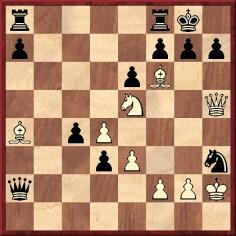
White to move
Javier Asturiano Molina (Murcia, Spain) asks about an early Nimzowitsch game with a spectacular finish (1 Be8), which the master published on pages 32-33 of his booklet Kak ya stal grosmeysterom (Leningrad, 1929):

The heading states that the game was played in Nuremberg in 1904 and that Black was ‘Hoffer’. We know of nothing to suggest that Leopold Hoffer was meant. When the position was given on page 62 of Heft 11 of the Baltische Schachblätter, 1908, Black was identified as ‘H. Hofer’, and the game was dated 1907:
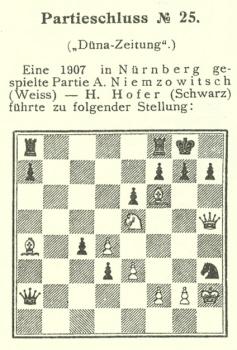
We have never come across the full game-score.
5605. ½
From Robert John McCrary (Columbia, SC, USA):
‘When did the system of counting draws as a half-point start? On page 8 of Transactions of the British Chess Association, 1866-67 I have found the following passage in the report on the preliminary meeting (3 September 1867) regarding that month’s tournament in Dundee:
“The Grand Tournament comprised ten competitors, each of whom was to contend one game with every other combatant, the prizes to be awarded according to the scores thus made. In order to obviate the difficulty experienced at the recent tournament in Paris, it was decided that a ‘draw’ should be reckoned as half a game to each player engaged in it.”
The tournament results on pages 8-9 gave the scores with the half-points included.
It is difficult to use modern compilations to determine when the “half-point” system began, because modern compilers sometimes present tournament and match scores of that period with the half-points even if the original tables did not use the system. So, which other original sources help to pinpoint the beginning of the half-point system for draws?’
We add a question of our own: which is the earliest known publication of a crosstable of an all-play-all (i.e. round-robin) tournament?
5606. Smyslov (1929)
Thomas Binder (Berlin) notes that an article about Bohatirchuk on pages 70-71 of the 6/2008 Rochade Europa includes this crosstable:
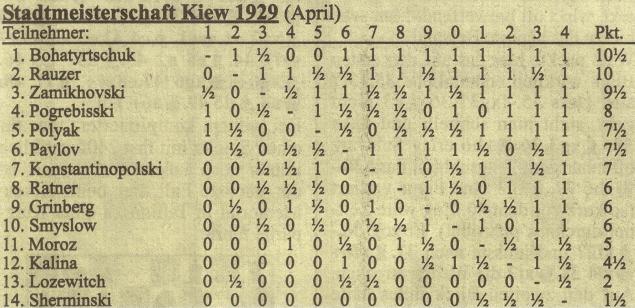
Our correspondent asks about the identity of the player who finished tenth.
Is it definitely established that he was Vassily Ossipovich Smyslov (1881-1943), the future world champion’s father? Pages 1-3 of 125 Selected Games by V. Smyslov (Oxford, 1983) featured reminiscences of early family life and included his father’s victory over Alekhine at St Petersburg, 1912. We should welcome further games played by Smyslov senior.
5607. Euwe line in the Winawer Variation
Thomas Niessen (Aachen, Germany) writes:
‘There is a line in the Winawer Variation of the French Defence which is often attributed to Euwe and in some sources is called the “Euwe-Gligorić line”. It occurs after 1 e4 e6 2 d4 d5 3 Nc3 Bb4 4 e5 c5 5 a3 Bxc3+ 6 bxc3 Ne7 7 Qg4 cxd4 8 Qxg7 Rg8 9 Qxh7 Qc7:
And now 10 Kd1, instead of 10 Ne2.
I have found two games with this line which were played in 1952 and 1953, and then three games played in 1960, after which the variation became more popular, but I have traced no games by either Euwe or Gligorić.
Moreover, already in 1960 Euwe wrote on page 79 of Part VIII of his Theorie der Schach-Eröffnungen (my translation):
“Another possibility in this kind of position is 10 Kd1, but the king move seems rather too sharp in this position.”
He then gave some analysis and presented moves from two games between E. Paoli and L. Schmid played in 1953 and 1960.
On what grounds has 10 Kd1 been named after Euwe (and Gligorić)?’
5608. Wahltuch v Griffith
In a discussion of aesthetics, C.N. 2257 (see page 145 of A Chess Omnibus) gave the following diagram (V.L. Wahltuch v R.C. Griffith, British championship, Richmond, 1912):

We commented:
‘In this position (taken from page 364 of the September 1912 BCM) Wahltuch preferred 60 Qg7+ to 60 Qxg8+. Is his choice aesthetically better, perhaps because it is a shorter move and less showy? Or is showy the word to describe 60 Qg7+, because it leaves Black with more redundant material? Or again, is it all much of a muchness?’
Below is the final phase of the game, as published in the BCM:
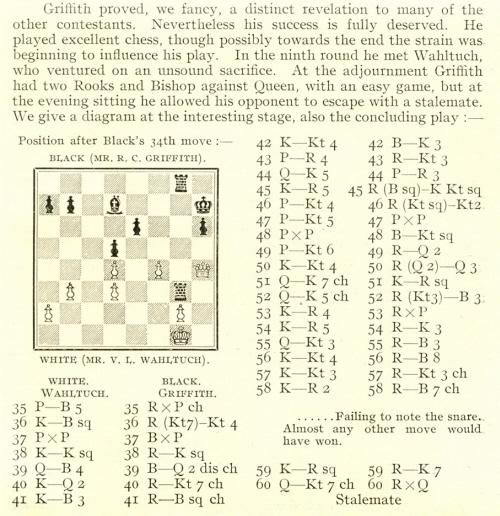
Griffith, who won the championship tournament, recalled the game on page 151 of the April 1932 BCM:
‘My success at Richmond was unexpected by myself and everybody else. Of course, I was particularly lucky. Atkins retired that year, and several players who invariably used to beat me never entered; why they accepted my entry I do not know. I wrote to Rees and said it was the only chance I should ever have of playing for the championship in the summer, and perhaps my special pleading softened the hearts of the selection committee. The work on MCO certainly bore fruit at Richmond, and J.H. White backed me up all he could, but the only chessplayer I could get to bet that I should be in the first half was J. Schumer. I was fortunate to lead throughout, although I made an ass of myself against V.L. Wahltuch. The heading the next morning in The Standard was amusing, “Griffith’s brilliant stalemate”. This was adding insult to injury. I found it very hard work, and my wife said I looked a wreck at the end of it, but these congresses are invariably well run, and I wish I could afford the time to enter another.’
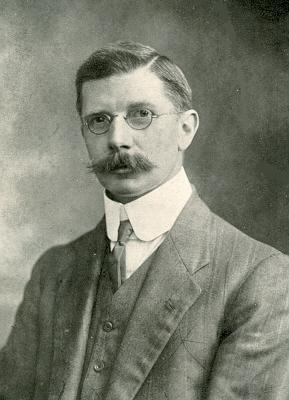
Richard Clewin Griffith (BCM, October 1912)
5609. Miniature not played
Still on the subject of R.C. Griffith, we reproduce C.N. 2756 (see pages 132-133 of A Chess Omnibus), because this miniature game continues to be misattributed to him: 1 e4 e5 2 Nf3 Nc6 3 Bb5 Nf6 4 d3 Ne7 5 Nxe5 c6 6 Nc4 cxb5 7 Nd6 mate.

Victory is ascribed to R.C. Griffith with such headings as ‘Birmingham, 1876’ (Essentia CD) and ‘1888’ (The Quickest Chess Victories of All Time by G. Burgess, page 179).
Griffith himself did his best to refute claims that he had ever won such a game. After J. du Mont gave the score (without any particulars) on pages 66-67 of The Elements of Chess (London, 1925), Griffith wrote on page 186 of the April 1925 BCM:
‘The smothered mate, No. XVIII, of Chapter VI, is credited wrongly to me. I have often told how, as a boy at school, I was caught in a trap set by Black’s fourth move, and stated that had I known the counter-trap at the time felt sure my opponent would have fallen into it, but alas I only learned it later.’
In the year du Mont died, 1956, Bell brought out The Elements of Chess in a ‘Revised Edition with the collaboration of Leonard Barden’, but (see pages 61-62) there was no revision regarding the alleged Griffith game, even though R.C.G. had given a more detailed denial on page 146 of the April 1932 BCM:
‘In 1886 I was one of the two boys chosen for the last place in the team [Charterhouse] and we had to play off. The other boy was in the Captain’s House and the Captain taught him Mortimer’s trap in the Ruy López, feeling sure I should play the Ruy López as it was then the opening, and I fell into it like a lamb. It was a pity I had not learnt the counter-trap, which I am sure would have come off: 1 e4 e5 2 Nf3 Nc6 3 Bb5 Nf6 4 d3 Ne7 5 Nxe5(?) c6, winning a piece. But if White replies 6 Nc4 and Black …cxb5, then 7 Nd6 is mate!’
5610. Against whom and when? (C.N. 5604)

White to move
From Hans-Georg Kleinhenz (Munich, Germany):
‘I have found the ending in two 1905 sources (Deutsches Wochenschach, 15 January, page 24, and L. Bachmann’s Schachjahrbuch für 1905, I. Teil, pages 90-91), so the date “1907” given in the Baltische Schachblätter is definitely wrong. Deutsches Wochenschach stated that the game was played “kürzlich in Nürnberg”, while Bachmann dated it as “Ende 1904 zu Nürnberg”. In both cases Black was named as “H. Hofer”. Additional analysis was published in the “Briefwechsel” on page 47 of the 29 January 1905 issue of Deutsches Wochenschach, showing that Black would have won after 2...gxf6 (instead of 2...gxh6) 3 Ng4 Qxf2.
Neither source gave the complete game.’
From page 90 of Schachjahrbuch für 1905, I. Teil by L. Bachmann (Ansbach, 1905):
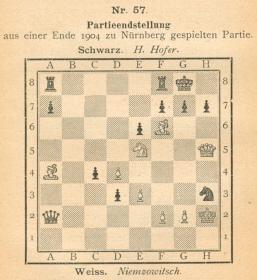
5611. Chandler and Capablanca

Dominique Thimognier (St Cyr sur Loire, France) quotes the final paragraph of Raymond Chandler’s novel, featuring Philip Marlowe, The High Window (1942):
‘It was night. I went home and put my old house clothes on and set the chessmen out and mixed a drink and played over another Capablanca. It went 59 moves. Beautiful cold remorseless chess, almost creepy in its silent implacability.
When it was done I listened at the open window for a while and smelled the night. Then I carried my glass out to the kitchen and rinsed it and filled it with ice water and stood at the sink sipping it and looking at my face in the mirror.
“You and Capablanca”, I said.’
Our correspondent notes four victories by Capablanca in 59 moves (all as White): against J. Corzo (Havana, 1901), Oskam (Middelburg, 1911), Whitaker (Washington, 1915) and Horowitz (New York, 1931).
We add that the first of these was given on page 130 of The Unknown Capablanca by David Hooper and Dale Brandreth (London, 1975), with this concluding note:
‘An endgame of master class, apart from a few hesitations; but even a master would hardly play it as fast – a rate of 147 moves an hour.’
It seems highly unlikely, however, that the game was ever accessible to Chandler. Although published in the Cuban press at the time, it was long regarded as untraceable. It was presented in an article by Paul Leith on pages 325-326 of the November 1960 BCM, following research by Miguel Alemán.
The Oskam game was given on pages 38-39 of our
monograph on Capablanca, taken from the Middelburgsche
Courant of 9 September 1911. Our book (page 87)
also included the Whitaker game, from pages 70-71 of the
April 1915 American Chess Bulletin. Both
victories occurred in simultaneous exhibitions.
Capablanca’s (tournament) win over Horowitz has always been readily available, without being widely anthologized.
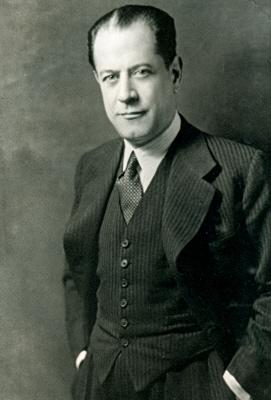
José Raúl Capablanca
The High Window has a number of references to chess, and particularly in chapter 15, which begins:
‘The chessmen, red and white bone, were lined up ready to go and had that sharp, competent and complicated look they always have at the beginning of a game.
... I opened a little paper-bound book of tournament games published in Leipzig, picked out a dashing-looking Queen’s Gambit, moved the white pawn to queen’s four, and the bell rang at the door.’
Two or three pages later Marlowe says to his visitors:
‘I play over tournament games that have been recorded and published. There’s a whole literature about chess. Once in a while I work out problems. They’re not chess, properly speaking. What are we talking about chess for? Drink?’
5612. Chess literature in Hellenic
From Michael Syngros (Amarousion, Greece):
‘I have compiled a catalogue of chess literature in Hellenic (original or translations), including books by Hellenic authors in other languages, as well as works of fiction having some connection with chess. To the best of my knowledge, it is the only list to date which covers this subject in detail. At present, it comprises 14 pages, with 220 entries, plus 21 periodicals.’
We shall be pleased to pass on to our correspondent any requests from readers for a copy of his catalogue.
Mr Syngros has provided two illustrations: the cover of the first (1894) chess book in Hellenic (an original work) and the cover of the first chess periodical (1943):
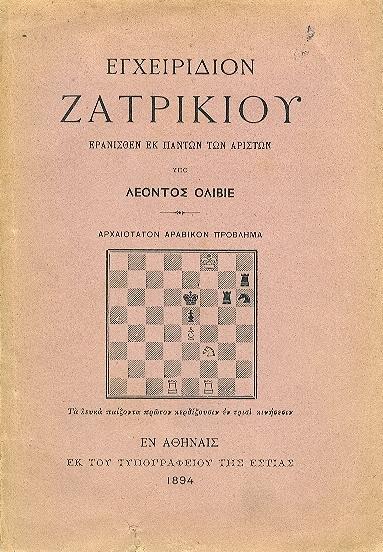
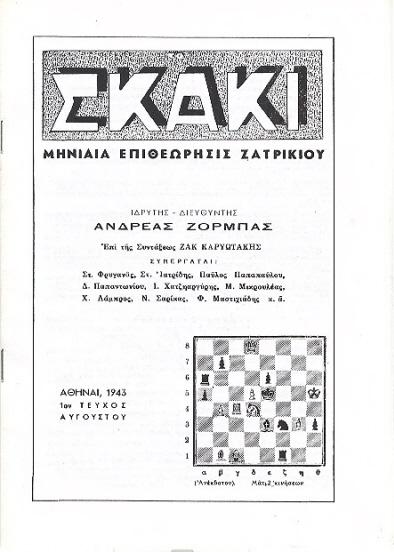
5613. Euwe line in the Winawer Variation (C.N. 5607)
The question asked in C.N. 5607 was why, after 1 e4 e6 2 d4 d5 3 Nc3 Bb4 4 e5 c5 5 a3 Bxc3+ 6 bxc3 Ne7 7 Qg4 cxd4 8 Qxg7 Rg8 9 Qxh7 Qc7, the move 10 Kd1 is credited to Euwe (and Gligorić).
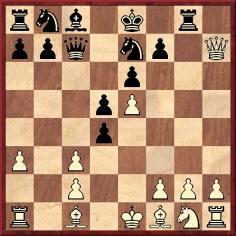
Roland Kensdale (Aberdeen, Scotland) notes that a similar, though not identical, opening was seen in Gligorić v Petrosian, Candidates’ tournament, 1959 (1 e4 e6 2 d4 d5 3 Nc3 Bb4 4 e5 c5 5 a3 Bxc3+ 6 bxc3 Qc7 7 Qg4 f5 8 Qg3 Ne7 9 Qxg7 Rg8 10 Qxh7 cxd4 11 Kd1) and that Gligorić discussed the line on pages 270-271 of his book I Play against Pieces (London, 2002). He gave the king move an exclamation mark and wrote:
‘The only way to meet the double threat on c3 and e5 and at the same time make possible a harmonious development of White’s pieces ...’
Moreover, Ola Winfridsson (Cambridge, England) quotes Mikhail Tal’s reference to that game on page 13 of Tal-Botvinnik 1960 (Milford, 2000), in a note after 11 Kd1 in the first game of that world title match:
‘... As far as I am concerned, the only game in which I came across the move 11 Kd1 (recommended, by the way, by Max Euwe) was in the above-mentioned Gligorić-Petrosian game.’
Our correspondent comments:
‘This is not the exact same variation (the moves 7...f5 8 Qg3 have been inserted), but the position is very similar (a pawn on f5 instead of f7). Perhaps some theoretician has confused the two variations and the moves 10 Kd1 and 11 Kd1.’
Oliver Beck (Seattle, WA, USA) points out that the Tal v Botvinnik game was annotated in the second volume of Kasparov’s Predecessors series, with this comment about 11 Kd1 on page 417 of the English edition:
‘A fantastic move, recommended in 1948 by Euwe and first tried in the game Gligorić-Petrosian (Yugoslavia Candidates 1959).’
Mr Beck mentions too that page 32 of The French Defence by S. Gligorić and W. Uhlmann (New York, 1975) attributed 10 Kd1 to Euwe, and our correspondent adds:
‘Interestingly, the Tal v Botvinnik game is also annotated in the Gligorić/Uhlmann book, but it is merely stated that 11 Kd1 “offers the best prospects”, with no mention of Euwe or the Gligorić-Petrosian game (page 118).’
We conclude with an addition of our own, given that Gligorić’s book I Play against Pieces referred (on page 270) to a game between Reshevsky and Botvinnik in the 1948 world championship and that Kasparov’s book stated, correctly, that 11 Kd1 was ‘recommended in 1948 by Euwe’. In the Reshevsky v Botvinnik game this note appeared after 8 Qg3 cxd4 on pages 200-201 of Euwe’s book Wereld-Kampioenschap Schaken 1948 (Lochem, 1948):
‘Om met Pe7 te kunnen voortzetten, welke zet thans zou falen op 9 Dg7: Tg8 10 Dh7: cd4: 11 Kd1! en Wit heeft goede aanvalskansen (11...De5: faalt op 12 Pf3 benevens 13 cd4:). In aanmerking kwam echter ook 8...Pc6.’
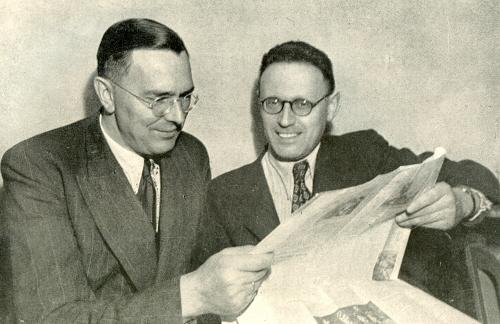
Max Euwe and Mikhail Botvinnik (photograph published opposite page 161 of the above-mentioned book by Euwe)
5614. Redcar, 1866
Michael McDowell (Westcliff-on-sea, England) asks about the photograph referred to as follows at the website of the Lewis Carroll Society:
‘Chess-Players, August 1866
This photograph, in Album P(3) of the Morris L. Parrish collection in Princeton University, was kept by Lewis Carroll but probably not taken by him. Almost certainly it shows thirty of the contestants and guests at the Redcar chess congress that Lewis Carroll attended on 10 August 1866. Most have not been identified, but Cecil De Vere, the winner of the main tournament, is pictured (the tall young man left of centre standing with his arms folded). To his left in front, seated holding his top hat is Howard Staunton. Two chess problemists, Walter Grimshaw (in the centre at the back, just to the right of Howard Staunton) and Henry E. Kidson (standing to the left and behind the seated gentleman with a stick on the right) are also probably identifiable.
This photograph is reproduced in (Taylor, page 205).’
The website does not give the photograph, and we are grateful to the Princeton University Press for permission to reproduce it here, from the fine book referred to above, Lewis Carroll Photographer by Roger Taylor and Edward Wakeling (Princeton and Oxford, 2002):
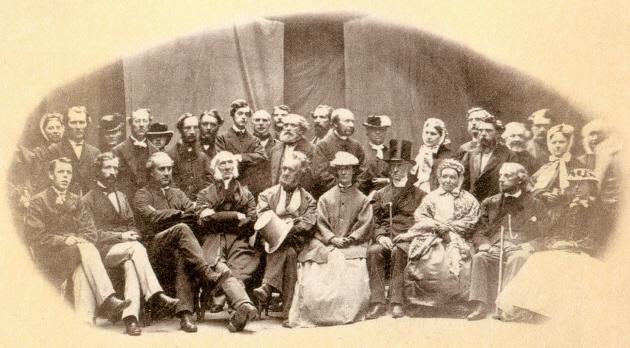
The caption reads as follows:

For a larger version of the photograph, click here. Below is a detail of Howard Staunton:
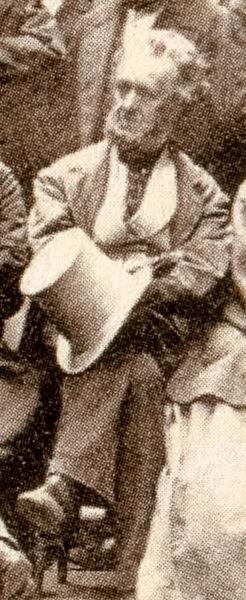
An account of the Redcar tournament appeared on pages 194-196 of the 1866 volume of Staunton’s periodical the Chess World. Organizational shortcomings were referred to (including ‘a want of liberality, a want of hospitality in the arrangements’), after which those in attendance were listed:

5615. Wahltuch v Griffith (C.N. 5608)

Position after 58 Ka2
From Lonnie Kwartler (Chester, NY, USA):
‘The BCM note to the move 58...Rc2+ said, “Almost any other move would have won”. However, the position was still a win after 59 Ka1 Rcc6 (instead of ...Re2) 60 Qe5+ Rf6 61 Ka2 Kg7 62 Ka1 (Otherwise there is no stalemate “snare”, as the BCM put it. 62 Ka3 also loses.) 62...Kf7 63 Ka2 Rb5 64 Qc7+ Kg6 65 Qg3+ Kh7 66 Qc7 Bf7 and ...Ra6+.’
5616. Fine on Alekhine (C.N. 5597)
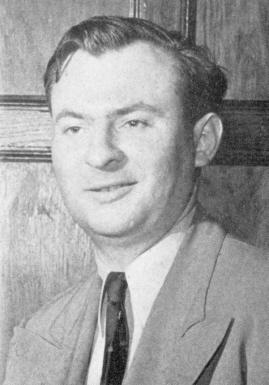
Reuben Fine
C.N. 5597 quoted contradictory statements by Reuben Fine about Alekhine as a psychologist, and we add here some further remarks of Fine’s, in a comparison between Alekhine and Keres on pages 142-143 of his book Chess Marches On! (New York, 1945):
‘Despite the many points of similarity there are a number of important respects in which they differ. Chief among these are Alekhine’s superior grasp of psychological factors and his all-consuming ambition ...
Reliance on psychology has been both an asset and a handicap for Alekhine. The legitimate use of psychology in master play is to maneuver the opponent into positions where he feels ill at ease, which do not “lie right” for him, as the German puts it. Alekhine has been able to apply this principle with consummate skill on a number of occasions – the match with Capablanca is the most notable. At other times, however, chiefly when he was at the height of his fame, around 1932-1934, Alekhine has exaggerated the human factor out of all proportion. In one French tournament he even went so far as to make a serious attempt to win by hypnosis.’
What exactly happened at that ‘one French tournament’?
Another question concerns the extent to which Fine applied (or claimed to apply) ‘psychological factors’ in his own games. That matter is raised tentatively, however, since few topics lend themselves so readily to waffle as does ‘chess psychology’.
5617. A smash
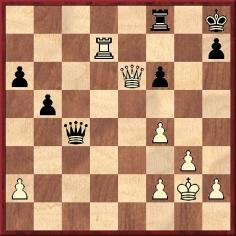
In this position, Black has just played 32...Qc1-c4. White exchanged queens and brought about his opponent’s resignation at move 46. This ending (Flohr v Noteboom, Hastings, 1930-31) was discussed on pages 4-6 of Practical End-Game Play by Fred Reinfeld (London, 1940), but when a copy of the book was awarded to C.G. Watson a decade later C.J.S. Purdy wrote on page 240 of Chess World, 1 October 1950:
‘Thanking us for it, he characteristically pointed out a flaw in the very first position in the book – “just to show he had looked at his prize”.
... Flohr exchanged queens and won a hard endgame. Instead, Watson points out a very pretty smash by 33 Q-K7 Q-N1 (forced) 34 R-Q8.
Black has to accept the rook, then White quickly wins it back, swaps queens, then plays K-B1 with two pawns up and a fatuously easy win in the pawn ending.’
Below is the full game, from page 14 of Československý Šach, January 1931:
Salo Flohr – Daniël NoteboomHastings (Premier Reserves), 2 January 1931
Nimzo-Indian Defence
1 d4 Nf6 2 c4 e6 3 Nc3 Bb4 4 Qc2 c5 5 dxc5 Bxc5 6 Nf3 b6 7 g3 Bb7 8 Bg2 d5 9 O-O dxc4 10 Qa4+ Bc6 11 Qxc4 Qc8 12 b3 Qb7 13 Bb2 Nbd7 14 b4 b5 15 Qb3 Be7

16 Bh3 Bxf3 17 exf3 O-O 18 f4 Rad8 19 Rfe1 a6 20 Bxe6 Bxb4 21 Qxb4 fxe6 22 Rxe6 Rde8 23 Rae1 Rxe6 24 Rxe6 Qc8 25 Ne4 Nxe4 26 Rxe4 Nf6 27 Re7 Qd8 28 Qb3+ Kh8 29 Qe6 Qc8 30 Bxf6 gxf6 31 Rd7 Qc1+ 32 Kg2 Qc4 33 Qxc4 bxc4 34 Rc7 Rb8 35 Rxc4 Rb6 36 Rc7 Rb2 37 Rc6 Rxa2 38 Rxf6 Kg7 39 Rb6 Ra5 40 g4 Ra4 41 Kg3 Ra3+ 42 f3 h6 43 h4 a5 44 g5 h5 45 f5 Ra1 46 Rb7+ Resigns.
Flohr contributed some notes to the Czech magazine but wrote nothing after move 20.
5618. Capablanca Chess
Jon D’Souza-Eva (Oxford, England) asks which configurations Capablanca advocated for a different form of chess. We give below three quotes from the Cuban’s writings which appeared in our book on him:
‘To make only the changes that are necessary, I have suggested that instead of 64 squares there should be 100, i.e. a 10x10 board instead of 8x8. There would thus be two extra pawns and two more major pieces behind them. To complete the range of moves, one of the pieces would have the combined moves of the bishop and knight, and the other those of the rook and knight. One would be placed on the queen’s side, the other on the king’s side. Instead of having the option of moving one or two steps, pawns would be able to move one, two or three.
The remaining rules would stay the same.’
Source: Article on Moscow, 1925 in Revista Bimestre Cubana, Volume XXI, Number 2, March-April 1926.
‘Personally, I am in favor of the 100-square board, 10 by 10, with two new pieces for each side, the one to have the powers of the rook and knight, and the other the powers of the bishop and knight. Where exactly these pieces should stand at the start can be settled later, though I suggest one each next to the king and queen; and there would be another minor change to consider, in giving permission for the pawns to move one, two or three squares on the first move, in order to bring the opposing sides more quickly in touch with one another. The broad principle is the 100-square board, which I prefer to the 80-square board, 10 by 8, and the new pieces.’
Source: Letter to The Times (London), 24 November 1928, page 13.
‘My own suggestions involve the introduction of new pieces upon the board: the Chancellor, combining the moves of the bishop and knight; and the Marshall [sic], combining the moves of the rook and the knight. This means to say that the Chancellor may be used either as a bishop or as a knight for any move according to the will of the player, while the Marshall in the same way can be used as a rook or knight. The latter piece, I think, would prove the stronger in an endgame. The introduction of these two pieces would of course mean a 100-squares board and two extra pieces on each side. But it would not entail any alteration of the rules.’
Source: Interview/article entitled ‘Brighter Chess’ on pages 44-45 of the Chess Amateur, November 1929.
Our monograph also quoted Edward Lasker on pages 427-428 of Chess Secrets I Learned from the Masters (New York, 1951) and on page 263 of the April 1974 Chess Life & Review. He indicated that in later years Capablanca came to prefer a 10x8 board, but we recall no writings to that effect by the Cuban or, indeed, anything published by him on ‘changing the rules’ after the 1920s.
There is an excellent entry for Capablanca Chess on pages 38-40 of The Encyclopedia of Chess Variants by David Pritchard (Godalming, 1994).
5619. Double Chess
The ‘Changing the Rules’ chapter of our Capablanca book also discussed Double Chess, and we had the pleasure of transcribing this game from pages 323-324 of the November 1929 issue of Magyar Sakkvilág:
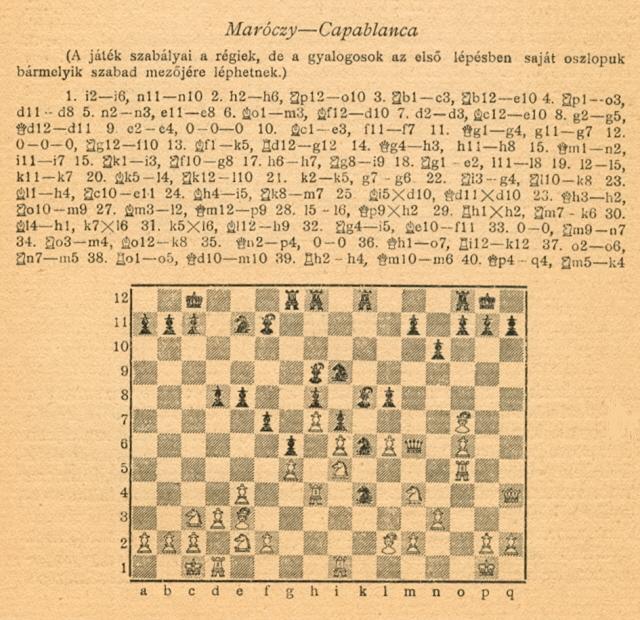
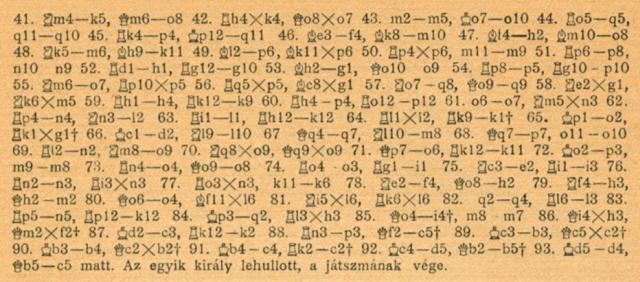
The photograph below of Capablanca and Maróczy in play was published on page 53 of Alt om Skak by B. Nielsen (Odense, 1943):

5620. Professor Hoffmann

Michael Clapham (Ipswich, England) draws attention to the above obituary notice on page 35 of the February 1920 BCM and asks for more information about Angelo Lewis.
His pseudonym was Professor Louis Hoffmann (not ‘Hoffman’ as given by the BCM and on page 186 of Betts’s Bibliography), and he produced The Games of Greco (London, 1900), as well as editions of Hoyle’s Games and books on magic and puzzles. In bibliographies he is sometimes referred to as Angelo John Lewis.
A preliminary examination of the familysearch.org website indicates that he was born in London on 23 July 1839, was a Master of Arts from Oxford University and a Barrister at Law, and died in 1918.
We shall be grateful if a reader can add to this outline.
5621. Marshall book
Palle Henriksen (Birkeroed, Denmark) reports that his copy of Marshall’s Chess “Swindles” by F.J. Marshall (New York, 1914) contains some handwritten comments:

- Page 12: ‘1st game I am proud of’ (Marshall v Atkins, cable match,1903);
- Page 105: ‘2nd best game’ (Marshall v Schlechter, Ostend, 1907);
- Page 18: ‘3rd best game’ (Marshall v Blackburne, cable match, 1910).
The Blackburne game (won after a lengthy ending) was not included in Marshall’s My Fifty Years of Chess (New York, 1942).
For purposes of comparison, it may be recalled that C.N. 4462 reproduced a Marshall inscription from our collection.
5622. Capablanca Chess (C.N. 5618)
From Yasser Seirawan (Amsterdam):
‘I love the powers of the two new pieces introduced by Capablanca but strongly dislike the names that he assigned to them: Chancellor and Marshall/Marshal. What imagery comes to mind with those names, and how could such images be converted into pieces for the chess board? What would they look like? Nor do I like the 10x10, or even the 10x8, board.
That is why Bruce Harper and I created a new chess variant. We renamed the Marshall/Marshal an Elephant (having the powers of the rook and knight) and the Chancellor a Hawk (with the powers of the bishop and knight).
The “novelty” lies in the way these new pieces are introduced into play, on an 8x8 chess board. At the start of the game they are out of play, and they do not appear on the board until there is a vacant square on the player’s back rank. Thus each player has a maximum of eight opportunities to bring in the two new pieces. They may be introduced on any move when one of the original pieces moves from the back rank. For instance, the opening move 1 Nf3 vacates the g1 square, and White would have three options: a) 1 Nf3, b) 1 Nf3/Hg1, and c) 1 Nf3/Eg1.
A practical example: 1 d4 d6 2 e4 e5 3 dxe5 dxe5 4 Qxd8/Ed1 mate.’
For more details, see the webpage Seirawan Chess.
5623. Zwischenzug (C.N. 4314)
It was mentioned in C.N. 4314 that the earliest occurrence of the word zwischenzug recorded by the Oxford English Dictionary (i.e. in an English-language text) was on page 108 of Fred Reinfeld’s 1941 book Keres’ Best Games of Chess 1931-1940.
We now note that Reinfeld had used the word on page 38 of the February 1938 Chess Review. At the end of his note on 17...h5 in game 19 of the previous year’s world championship match between Euwe and Alekhine he wrote:
‘However, a little Zwischenzug changes all that.’
5624. Chernev’s personal opinions
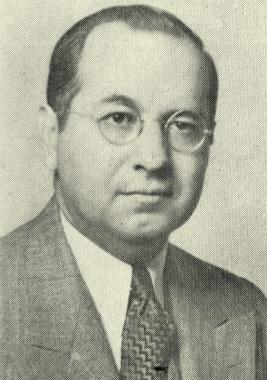
Irving Chernev
Chernev gave ‘some personal opinions’ on page 28 of the November-December 1933 Chess Review. They included the following:
- ‘The perfect game is Réti-Kostić, Teplitz, 1922.
- The most important game. Pillsbury-Tarrasch, Hastings, 1895.
- The most exhaustive – and exhausting – annotator is Tartakower.
- The laziest. Lasker and Teichmann.
- The most interesting matches were Alekhine-Bogoljubow, 1929, Tarrasch-Schlechter, 1911, and Capablanca-Euwe, 1931.
- The most interesting combinative game was Alekhine-Cohn, Stockholm, 1912.
- The coolest player under fire is Kashdan.
- The perfect annotators are Alekhine, Marco and Grünfeld.
- The game most interestingly annotated is Bernstein-Nimzowitsch, St Petersburg, 1914, by Marco in the Wiener Schachzeitung.
- The most brilliant move was move no. 36 R-Q5, in the game between Alekhine and Tartakower, Vienna, 1922.
- Perhaps the most overrated player was Morphy.
- The most underrated player was Teichmann.
- The greatest “natural” player was Zukertort.’
5625. Arturo Pomar
Andrés Vicente Sanz (Valencia, Spain) submits this photograph of Arturo Pomar taken at the Sociedad Musical de Alboraya in the late 1950s or early 1960s:

5626. Capablanca Chess (C.N.s 5618 & 5612)
Joose Norri (Helsinki) notes a webpage of the British Chess Problem Society with an impressive survey by T.R. Dawson of ‘new’ pieces introduced over the centuries. See, in particular, the reference to Carrera’s insertion in 1617 of two new pieces, the campione and centaur, on a 10x8 board.
5627. George Bernard Shaw and chess
Leibel Dearson (Jerusalem) draws attention to the following remark by George Bernard Shaw:
‘As I write these lines the newspapers are occupied by the exploits of a child of eight, who has just defeated 20 adult chessplayers in 20 games played simultaneously, and has been able afterwards to reconstruct all the 20 games without any apparent effort of memory. Most people, including myself, play chess (when they play it at all) from hand to mouth, and can hardly recall the last move but one, or foresee the next but two.’
Source: Back to Methuselah. A Metabiological Pentateuch by G. Bernard Shaw (London, 1921), page xxv.
The prodigy in question was evidently Reshevsky.

The best-known remark about chess by Shaw appeared in The Irrational Knot:
‘Playing with Ned! No: he hates chess. He says it is a foolish expedient for making idle people believe they are doing something very clever when they are only wasting their time. He actually grumbled about the price of the table and the pieces; but I insisted on having them, I suppose in remembrance of you.’
This was quoted, in part, on page 30 of Chess Pieces by Norman Knight (London, 1949), after which Knight reported that he had asked Shaw whether he still held that opinion. In a postcard dated 22 August 1946 Shaw replied:
‘I have no recollection of the passage. I am hopeless as a chessplayer; I never can see more than two moves ahead. I was taught the names of the pieces and the moves by my Mother when I was a child; but my genius did not point in that direction.’
Page 21 of King, Queen and Knight by Norman Knight and Will Guy (London, 1975) quoted from Shaw’s The Admirable Bashville:
‘The world’s a chess-board,
And we the merest pawns in fist of fate.’
5628. Lewis Carroll photograph (C.N. 5614)
We are grateful to the Princeton
University Press for permission to reproduce a second
chess photograph from Lewis
Carroll
Photographer by Roger Taylor and Edward
Wakeling (Princeton and Oxford, 2002). It appears on
page 145:

5629. Strange odds
Mark McCullagh (Belfast, Northern Ireland) points out a proposal by Horatio Bolton in a letter published on page 318 of the Chess Player’s Chronicle, 1852:
‘A new specimen of odds which, so far as I know, originates with myself, has been lately patronized here, and I wish for your judgment as to the relative strength of the parties.
The first player alone agrees not to check his adversary until he can effect checkmate; in every other respect the game is played as usual on both sides. These odds, I believe, are equal to giving a queen, and they occasion very striking positions.’
5630. Spot the master
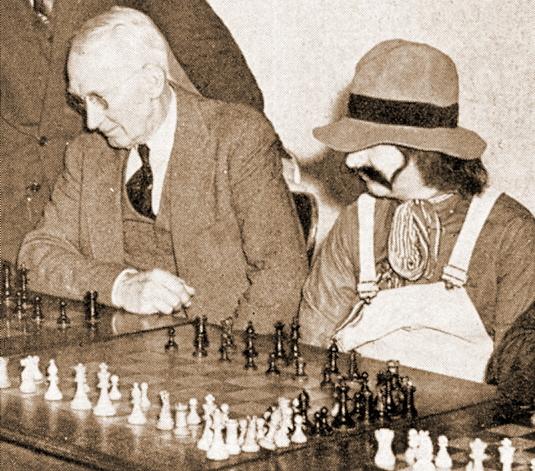
5631. Alekhine interview
Two excerpts from an interview with Alekhine by Isaac Kashdan on pages 9-10 of the September 1933 Chess Review:
‘Particularly in Asia I was interested in the number of different peoples that play chess, and also in the varieties of the game itself. It is there that chess probably originated. I found several simple forms, and others even more complicated than the game we know. It may be, in time, that we can combine the best features of the Oriental game with our chess. This would be a more natural evolution than adding new pieces and squares, or some of the other changes that have been proposed. I do not believe that chess needs any change at present, as it still holds new wonders, and will continue to do so for years to come.’
‘I do not believe it is the function of the world’s champion to go on constant barnstorming tours. I wanted to make the world trip to become personally familiar with the conditions of chessplaying everywhere, and also to meet so many individuals whom I had known through magazine pages or correspondence. But I believe I can do more for chess in other ways, notably by writing. With more leisure, I could work out methods of instruction, and perhaps eventually be at the head of a vast system of schools and coaches, as has happened in contract bridge under Ely Culbertson. This would mean many new converts of chess, and cause a great awakening of public interest, as more and more people were initiated into the mysteries of our glorious game.’
5632. Réti v Alekhine

Alexander Alekhine
From page 99 of Chess Lists by A. Soltis (Jefferson, 2002):
‘Against Richard Réti at Baden-Baden 1925, Alekhine omitted two moves that repeated the position in what turned out to be perhaps his finest game.’
Having found three versions of the game-score, we wonder whether the matter is so clear-cut.
- A) 1 g3 e5 2 Nf3 e4 3 Nd4 d5 4 d3 exd3 5 Qxd3 Nf6 6 Bg2 Bb4+ 7 Bd2 Bxd2+ 8 Nxd2 O-O 9 c4 Na6 10 cxd5 Nb4 11 Qc4 Nbxd5 12 N2b3 c6 13 O-O Re8 14 Rfd1 Bg4 15 Rd2 Qc8 16 Nc5 Bh3 17 Bf3 Bg4 18 Bg2 Bh3 19 Bf3 Bg4 20 Bg2 Bh3 21 Bf3 Bg4 22 Bh1 h5 23 b4 a6 24 Rc1 h4 25 a4 hxg3 26 hxg3 Qc7 27 b5 axb5 28 axb5 Re3 29 Nf3 cxb5 30 Qxb5 Nc3 31 Qxb7 Qxb7 32 Nxb7 Nxe2+ 33 Kh2 Ne4 34 Rc4 Nxf2 35 Bg2 Be6 36 Rcc2 Ng4+ 37 Kh3 Ne5+ 38 Kh2 Rxf3 39 Rxe2 Ng4+ 40 Kh3 Ne3+ 41 Kh2 Nxc2 42 Bxf3 Nd4 43 White resigns.
The Baden-Baden tournament books by Tarrasch (Berlin, 1925) and by Caissa Editions (Yorklyn, 1991).
- B) 1 g3 e5 2 Nf3 e4 3 Nd4 d5 4 d3 exd3 5 Qxd3 Nf6 6 Bg2 Bb4+ 7 Bd2 Bxd2+ 8 Nxd2 O-O 9 c4 Na6 10 cxd5 Nb4 11 Qc4 Nbxd5 12 N2b3 c6 13 O-O Re8 14 Rfd1 Bg4 15 Rd2 Qc8 16 Nc5 Bh3 17 Bf3 Bg4 18 Bg2 Bh3 19 Bf3 Bg4 20 Bh1 h5 21 b4 a6 22 Rc1 h4 23 a4 hxg3 24 hxg3 Qc7 25 b5 axb5 26 axb5 Re3 27 Nf3 cxb5 28 Qxb5 Nc3 29 Qxb7 Qxb7 30 Nxb7 Nxe2+ 31 Kh2 Ne4 32 Rc4 Nxf2 33 Bg2 Be6 34 Rcc2 Ng4+ 35 Kh3 Ne5+ 36 Kh2 Rxf3 37 Rxe2 Ng4+ 38 Kh3 Ne3+ 39 Kh2 Nxc2 40 Bxf3 Nd4 41 White resigns.
Alekhine’s second volume of Best Games;
Auf dem Wege zur Weltmeisterschaft by Alekhine (Berlin and Leipzig, 1932);
Pages 100-101 of L’Echiquier, May 1925 (notes by Alekhine);
The Baden-Baden tournament book by N. Grekov (Moscow, 1927). It gave Alekhine’s annotations from Shakmaty, which were the same as those published in L’Echiquier;
G. Renaud, in L’Eclaireur du Soir, as reproduced on page 75 of the April 1925 L’Echiquier;
A. Rubinstein in La Nation Belge, as reproduced on page 124 of the June 1925 La Stratégie;
C.S. Howell in the American Chess Bulletin, May-June 1925, pages 94-95;
Les Cahiers de l’Echiquier Français, issue 6 (1926), page 182.
- C) 1 g3 e5 2 Nf3 e4 3 Nd4 d5 4 d3 exd3 5 Qxd3 Nf6 6 Bg2 Bb4+ 7 Bd2 Bxd2+ 8 Nxd2 O-O 9 c4 Na6 10 cxd5 Nb4 11 Qc4 Nbxd5 12 N2b3 c6 13 O-O Re8 14 Rfd1 Bg4 15 Rd2 Qc8 16 Nc5 Bh3 17 Bf3 Bg4 18 Bh1 h5 19 b4 a6 20 Rc1 h4 21 a4 hxg3 22 hxg3 Qc7 23 b5 axb5 24 axb5 Re3 25 Nf3 cxb5 26 Qxb5 Nc3 27 Qxb7 Qxb7 28 Nxb7 Nxe2+ 29 Kh2 Ne4 30 Rc4 Nxf2 31 Bg2 Be6 32 Rcc2 Ng4+ 33 Kh3 Ne5+ 34 Kh2 Rxf3 35 Rxe2 Ng4+ 36 Kh3 Ne3+ 37 Kh2 Nxc2 38 Bxf3 Nd4 39 White resigns.
R. Spielmann, Wiener Schachzeitung, May 1925, pages 135-136;
Deutsche Schachzeitung, May 1925, pages 147-148.
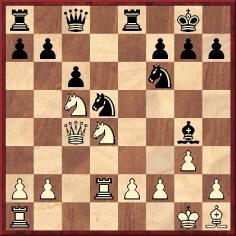
Position before ...h5
So, did Alekhine play ...h5 on move 22, 20 or 18? Did he really abridge the score, even though his version is by far the most common and despite publication in the Wiener Schachzeitung and the Deutsche Schachzeitung of a version that was shorter still?
When the game was presented on pages 35-40 of Chess Masterpieces by F.J. Marshall (New York, 1928) the United States champion introduced it as follows:
‘At the conclusion of the 1927 New York tournament I asked Dr Alekhine, now the world’s champion, which he considered to be his best game, and was pleased when he selected the one he played against Réti in the 1925 Baden-Baden tournament. I was present when this fine game was played and won the admiration of both the masters and the public. Dr Alekhine thinks he has nothing to add to the notes made by Mr C.S. Howell in the American Chess Bulletin and the comments I made in discussing this remarkable game.’
The game-score followed (version B above), with notes adapted from Howell’s on pages 94-95 of the May-June 1925 American Chess Bulletin. Howell mentioned that Réti had annotated the game in La Prensa (Argentina), and we should like to know which version of the game-score Réti gave.
5633. Switched envelopes (C.N. 4404)
C.N. 4404 quoted from page 51 of A. Alekhine Agony of a Chess Genius by P. Morán (Jefferson, 1989):
‘The 1942 “switched envelopes” anecdote best illustrates Alekhine’s patriotism: he mailed a pro-Communist letter to the Third Reich, and a pro-Nazi letter to the USSR.’
We asked how far back the story could be traced, and all we can offer at present is a very weak citation, from page 210 of The World’s Great Chess Games by Reuben Fine (New York, 1951):
‘He was supposed to have written two letters, one to the Russians extolling the Communist system, the other to the Germans praising the Nazi system, and put them in the wrong envelopes. Apocryphal or symbolic?’
5634. Computer game
C.N. 1821 (see page 81 of Chess Explorations) quoted a claim on page 60 of John Curdo’s Chess Career. Forty Years at the Top (Coraopolis, 1988):
‘I believe to this day that I am the first master to engage a computer program in rated tournament play.’
The game, against Mac Hack, was played at the Greater Boston Open on 9 October 1971 and is available in databases.
5635. Who?
Who wrote the following?
‘I have played against the following noted players, winning the first game that I contested with each master, namely: Zukertort, Steinitz, Lasker, Pillsbury and Max Weiss.’
5636. Koltanowski v Dunkelblum
C.N. 2378 (see pages 347-348 of A Chess Omnibus) discussed a pair of victories by Koltanowski over ‘Dunkelblum’, and below we quote the first two paragraphs of that item:
‘Dunkelblum’ is often given as the name of the player who lost two of the most frequently published games featuring the late George Koltanowski, i.e. the 13 Qd8+ brilliancy (‘Antwerp, 1923’) and this more sophisticated encounter (‘Antwerp, 1929’): 1 e4 e5 2 Nf3 Nc6 3 Bc4 Bc5 4 O-O Nf6 5 d4 exd4 6 e5 d5 7 exf6 dxc4 8 Re1+ Be6 9 Ng5 Qd5 10 Nc3 Qf5 11 Nce4 Bb4 12 c3 dxc3 13 bxc3 Ba5 14 g4 Qg6 15 Nxe6 fxe6 16 f7+ Kxf7 17 Ng5+ Kg8 18 Rxe6 Qd3 19 Qe1 Rf8 20 Re8 Qd7 21 Rxf8+ Kxf8 22 Ba3+ Ne7
23 Rd1 Qxg4+ 24 Kf1 Qxg5 25 Rd5 Qh4 26 Rh5 Qf6 27 Rf5 Resigns.
On page 27 of his book Adventures of a Chessmaster Koltanowski gave the former game as played against A. Dunkelblum in ‘an eight-game blindfold exhibition at Antwerp in 1923’. However, on page 35 of Checkmate Strategies (co-authored by Koltanowski and M. Finkelstein) the heading was ‘Antwerp, 1931’. As regards the second game, both books agreed on ‘Antwerp, 1929’, but the former (page 38) gave Black’s name as ‘P. Dunkelblum’ (Koltanowski also referred to ‘my boyhood chum, Dunkelblum’) whereas the latter volume had ‘Dunkelbaum’. Where Arthur Dunkelblum (see page 82 of Histoire des maîtres belges by M. Wasnair and M. Jadoul) may fit in with all this is more than we would dare guess.
Now Christian Sánchez (Rosario, Argentina) writes:
‘The second Koltanowski-Dunkelblum game was given on page 444 of the November 1928 issue of El Ajedrez Americano with a transposition of moves and a different ending:
1 e4 e5 2 Nf3 Nc6 3 Bc4 Bc5 4 O-O Nf6 5 d4 exd4 6 e5 d5 7 exf6 dxc4 8 Re1+ Be6 9 Ng5 Qd5 10 Nc3 Qf5 11 g4 [Instead of 11 Nce4 Bb4 12 c3 dxc3 13 bxc3 Ba5 14 g4 Qg6] 11...Qg6 12 Nce4 Bb4 13 c3 dxc3 14 bxc3 Ba5 15 Nxe6 fxe6 16 f7+ Kxf7 17 Ng5+ Kg8 18 Rxe6 Qd3 19 Qe1 Rf8 20 Re8 Qd7 21 Rxf8+ Kxf8 22 Ba3+ Ne7 23 Rd1 Qxg4+ 24 Kf1 Qxg5 25 Rd5 Bxc3 [Rather than 25...Qh4 26 Rh5 Qf6 27 Rf5] 26 Qe6 Resigns.
No occasion was indicated, but the score was presented, by Koltanowski himself, as being among “short, pretty games in small tournaments held lately in Europe”.’
5637. The Hague, 1928
This photograph was published on page 403 of El Ajedrez Americano, October 1928:

5638. An old story (C.N. 4349)
C.N. 4349 referred to a story which Irving Chernev was fond of telling:
‘In 1850 an old passion for chess awoke in Szechenyi (founder of the Magyar Academy) and took an insane character. It became necessary to pay a poor student to play with him for 10 or 12 hours at a time.
Szechenyi slowly regained his sanity, but the unfortunate student went mad.’
We noted that the above appeared on page 40 of Chernev’s book Wonders and Curiosities of Chess (New York, 1974), and that a similar version (‘The unfortunate student went mad, but Szechenyi slowly became sane’) was given by him on page 14 of Chessworld, January-February 1964 and on page 56 of Curious Chess Facts (New York, 1937).
It was mentioned that in Curious Chess Facts (an item previously published on page 30 of the February 1935 Chess Review) Chernev gave a source, ‘Lombroso in The Man of Genius’, and we can now reproduce what appeared on page 87 of Cesare Lombroso’s book (published in London in 1891):
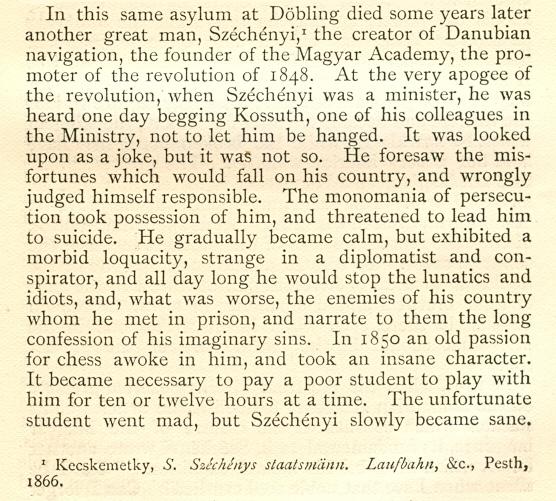
As regards the footnote, the author of the 1866 volume, which we have not seen, should read (István) Kecskeméthy.
5639. Simultaneous display (C.N.s 5025 & 5028)
C.N.s 5025 and 5028 asked for more information about an event described as follows on page 260 of An illustrated Dictionary of Chess by Edward R. Brace (London, 1977):
‘The greatest simultaneous display was undertaken by G.J. Martin in London in 1957. He played 142 opponents, defeating 130, drawing 11 and losing to one in less than four hours 40 minutes.’
Jonathan Manley (Oxford, England) now reports that earlier this month Professor Geoffrey J. Martin confirmed to him that Brace’s account was accurate, except that the display took place in December 1956. Mr Manley has also forwarded to us, courtesy of a participant in the display, Ivor Smith (Writtle, England), an extract from a report in the Chronicles of the Ilford County High School for Boys (January 1957, pages 21-22):
‘One of the big events of the term was the simultaneous display by G.J. Martin which started at 2.20 on Friday 14 December in the canteen. Besides many boys from our own school, there were several from other schools in the district taking part. In all during the five hour display, Martin won 130, drew 11 and lost one, this game being against Pemberton of Bancroft School. By playing 142 games, Martin has beaten the previous British record of 126 set up in 1941 by B.H. Wood at our school.
G.J. Martin is an old boy of the school, plays for Essex on a very high board, has qualified in three successive years for the British Championship and has represented a British Universities’ team at Oslo and Upsala.’

The above picture of Geoffrey Martin is a detail from a 1954 group photograph which was published on, for instance, page 58 of A History of Chess by J. Giżycki (London, 1972).
Professor Martin has also given Mr Manley these two games:
Eduard Spanjaard – Geoffrey MartinBeverwijk (B), 1955
Budapest Defence
1 d4 Nf6 2 c4 e5 3 dxe5 Ng4 4 Bf4 Bb4+ 5 Nd2 d6 6 exd6 Qf6 7 e3
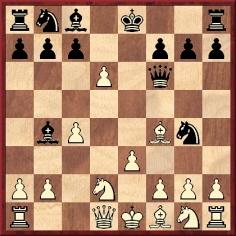
7...Nxf2 8 Kxf2 g5 9 Ne4 Qxb2+ 10 Ne2 gxf4 11 Qd4 fxe3+ 12 Kxe3 Qxd4+ 13 Nxd4 Bxd6 14 Nxd6+ cxd6 15 Nb5 Na6 16 Nxd6+ Ke7 17 Nb5 Drawn.
Edmar Mednis – Geoffrey MartinWorld Student Team Championship, Reykjavik, 1957
Dutch Defence
1 d4 f5 2 c4 e6 3 Nf3 Nf6 4 Nc3 Be7 5 g3 O-O 6 Bg2 d6 7 O-O Qe8 8 Re1 Qg6 9 e4 fxe4 10 Nxe4 Nxe4 11 Rxe4 Nc6 12 Re1 Nb4 13 a3 Nc2 14 Nh4 Bxh4 15 Be4
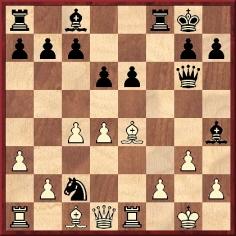
15...Nxe1 16 Bxg6 Nf3+ 17 Kg2 hxg6 18 gxh4 Nxh4+ 19 Kg3 Nf5+ 20 Kg2 Nh4+ 21 Kg3 Nf5+ Drawn.
We add a few comments on B.H. Wood’s simultaneous display in Ilford. This report appeared on page 130 of the June 1941 issue of his magazine, CHESS:
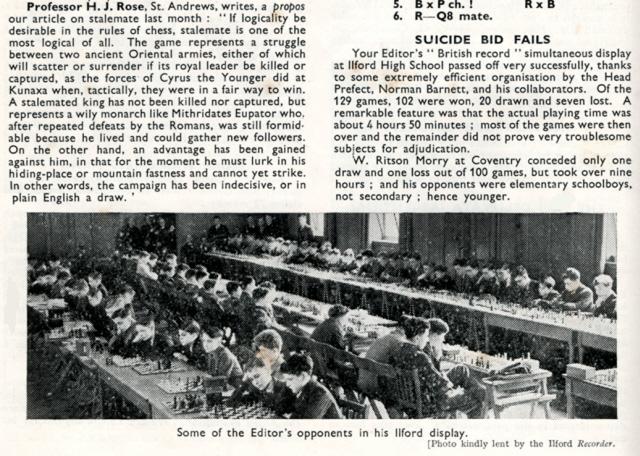
In contrast, page 166 of the June 1941 BCM stated that 127, not 129, games were played (+102 –7 =18). A total of 127 was indicated by Wood himself when the above photograph was given opposite page 63 of his Easy Guide To Chess (Sutton Coldfield, 1942).
5640. Spot the master (C.N. 5630)

This photograph dates from the 1940s, but we introduced a sepia herring. The full picture, from page 219 of the November 1942 Chess Review, appears below:
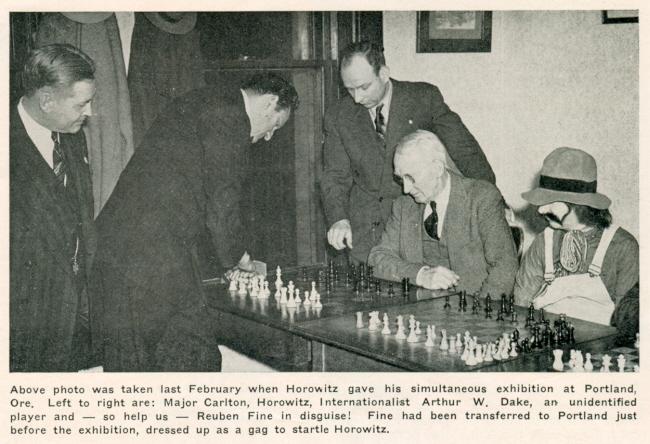
David Abrams (Syracuse, NY, USA) not only identified Reuben Fine but pointed out this ‘country cousin’ passage on page 25 of Fine’s book Lessons from My Games (New York, 1958):
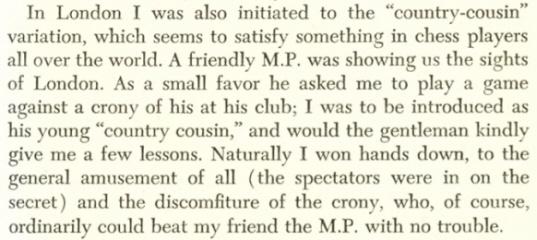
5641.
P. Wenman and plagiarism
The final paragraph of our Historical Havoc article referred, by no means appreciatively, to (Francis) Percival Wenman (1891-1972), and the present item focuses on his chess problem books. Page 310 of the 1992 edition of The Oxford Companion to Chess described him as ‘the problem world’s most notorious plagiarist’ and added regarding his 1943 work Problems & Puzzles: ‘Of the 70 problems in this book at least 40 owe their origin to other composers.’ Page 192 of The Even More Complete Chess Addict by M. Fox and R. James (London, 1993) stated that Wenman’s One Hundred Published Chess Problems ‘was notable for containing a quantity of problems by just about anybody but Percy Wenman’.
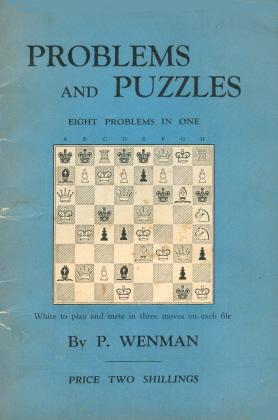
We have been re-examining all of Wenman’s problem books, wondering whether a devil’s advocate could construct any kind of defence for him.
With some of Wenman’s output, no issue of plagiarism arises. For instance, in 1946 he brought out two small (approximately 9 x 11.5 cm) booklets on problems by Guidelli and Ehrenstein in which he named himself merely as the compiler. The same year, he published Thirty Two-Movers in a similar format. Each problem was attributed to a composer, and two of them to Wenman. That was also the case with Thirty Three-Movers, issued in 1945.
For the charge of serial plagiarism, that leaves the following, larger, problem books (many of which were reissued/reprinted surprisingly often in the 1940s):
- 50 Two-Move Problems (1940). In the Preface (page 2) Wenman stated that he had composed all 50 problems:

- Problems & Puzzles (1943). No composers’ names were given for the 70 problems. Wenman’s Preface did not specifically say that he had composed them, but that was the implication (since the book was ‘on similar lines’ to 50 Two-Move Problems). The title page stated ‘Problems & Puzzles by P. Wenman’.
- One Hundred Published Problems (1944). No composers’ names were given. Again, the Preface did not state outright that Wenman had, or had not, composed the problems, but the title page read ‘One Hundred Published Problems by P. Wenman’.
- 111 Selected Problems by Famous Composers (1945). Each composer was named, with no problems ascribed to Wenman.
- Two Hundred Assorted Problems (1945). No composers’ names were given. Once more, the Preface did not indicate whether or not Wenman had composed the problems, but the title page read ‘Two Hundred Assorted Problems by P. Wenman’. Wenman’s remark in the Preface, ‘Some have been published previously, but not all’, implied that he was the composer.
- Six Hundred Problems Ancient and Modern
(1948). Each composer was named, with problems 591-599
attributed to Wenman. Four of those specimens are
shown below.
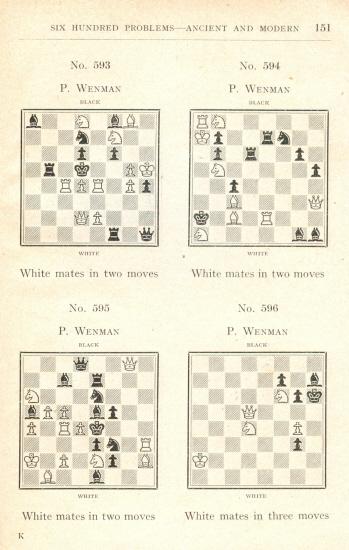
The devil’s advocate might therefore clutch hopefully at the absence of a direct claim to problem authorship by Wenman in the two books singled out by the Oxford Companion and the Addict book, i.e. Problems & Puzzles and One Hundred Published Problems. Only 50 Two-Move Problems contained an explicit statement by Wenman that he had composed the entire contents. However, it was established in the 1940s that Wenman not only lifted other composers’ work (50 Two-Move Problems was just one of the books found guilty) but also sometimes tampered with it (e.g. through rotation of the board), and that such perceived attempts to disguise the original authorship often impaired the composition. All this was demonstrated in an irrefragable exposé by ‘C.S.K.’ (Kipping) on pages 74-78 of CHESS, December 1946. An extract from page 75 illustrates the level of Kipping’s research and of Wenman’s piracy:
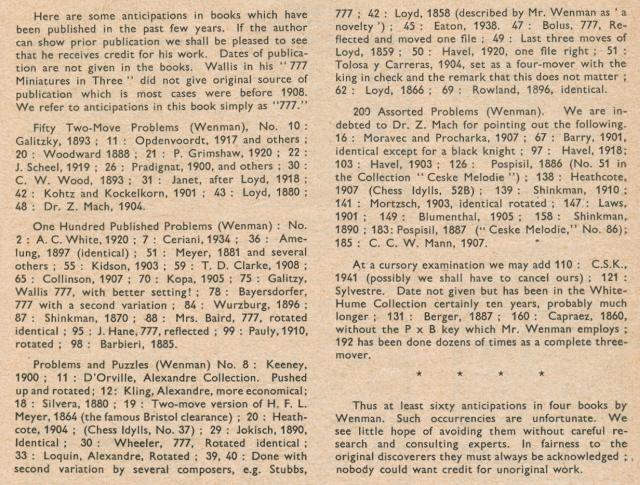
And so the devil’s advocate peters out. We have seen no response by Wenman to Kipping’s indictment, although one comment by Wenman on the subject of originality in composition comes to mind. It appeared on page 8 of the Falkirk Herald of 24 September 1941 and was reprinted on page 21 of the January 1942 BCM:
‘I do not think very much of some of the critics who always say: “it must have been anticipated” – or something to that effect. Actually there are no entirely original problems today by anyone, and there never will be, because all chess ideas are exhausted long ago. Positions are only recast; and if one has never seen a position before it is quite original so far as the new composer is concerned.’
Did Wenman genuinely believe that his large-scale
‘recasting’ was legitimate and ethical?
His anthologies on chess play were also deplorable, although not on grounds of plagiarism. The fact that One Hundred Remarkable Endings was described as ‘an excellent piece of work’ on page 227 of the 14 February 1939 CHESS simply shows that any chess book will be praised somewhere by someone. The fact that in 1995 Cadogan Books reissued Wenman’s One Hundred Chess Gems simply shows that any chess book may find itself reprinted by an undiscriminating or vulturine publisher.
About Wenman himself little information is currently to hand, beyond the basic record of his tournament and match play. Page 708 of the August 1912 issue of the Chess Amateur reported:
‘Wenman. This talented young expert, who has done so much for chess in Glasgow and the West of Scotland, is leaving for Canada. Some of his chess friends are promoting a testimonial to him’.
Whether he ever crossed the Atlantic we are not sure. Certainly he was in Scotland in the first months of the following year (BCM, April 1913, page 148), and the magazine carried a number of reports on his chess activities in Scotland during that decade.
Finally, a rare photograph of Wenman (in a group shot
taken at Edinburgh, 1920, a few months after he became
Scottish Champion) was published on page 277 of the
September 1920 BCM:
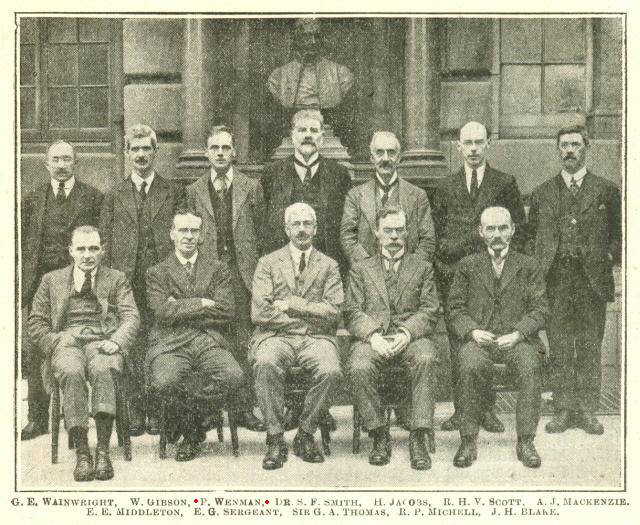
5642. Scotland’s admission to FIDE
From page 342 of the August 1932 BCM:
‘We were extremely pleased to hear that at the recent annual meeting of the FIDE at Paris, Scotland was admitted to membership. We extend a cordial hand of welcome to our Northern friends, and shall look forward to seeing a Scottish team competing in the Team Tournament for the Hamilton-Russell Cup at Folkestone next June.’
Two years previously the Scottish Chess Association had proposed leaving the British Chess Federation and joining FIDE, but its application was unanimously rejected (8-0) by FIDE delegates, with Germany, Belgium, Great Britain and the Netherlands abstaining and the British Chess Federation expressing absolute neutrality:
‘La candidature de la Fédération écossaise, qui se propose de quitter la British Chess Federation, donne lieu à une discussion. Elle est repoussée par 8 voix contre 0, avec abstentions (Allemagne, Belgique, Grande-Bretagne, Pays-Bas), le délégué de la Grande-Bretagne ayant déclaré que sa Fédération adoptait la plus stricte neutralité dans cette affaire.’
Source: Procès-verbal du VIIe Congrès, Hambourg, 23-26 juillet 1930 (The Hague, 1931), page 8.
Two years later, a fresh application was made by Scotland. The FIDE President, Alexander Rueb, set up a small Commission in which he was joined by W. Robinow (Germany) and E. St John Mildmay (Italy). The group reported favourably on Scotland’s candidacy, which was then accepted unanimously by delegates (with Great Britain abstaining):
‘Demande de filiation de la Fédération nationale de l’Ecosse
Cette fédération présente à nouveau sa demande d’admission dans la FIDE; la British Chess Federation se déclare neutre pour cette question; afin de ne pas prendre de décision contraire aux statuts, Monsieur le Président propose le renvoi à une Commission qui rapportera à la séance de relevée; cette commission est composée de MM. Rueb, Robinow et Mildmay.
La Commission rapporte favorablement; l’admission est votée à l’unanimité sauf la Grande-Bretagne; le délégué de la Brit. Chess Federation s’abstient mais confirme la neutralité de sa fédération.’
Source: Procès-verbal du IXe Congrès à Paris, 18-20 juillet 1932 (The Hague, 1932), page 4.
The British Chess Federation’s delegate on both occasions was Victor Wahltuch.
| First column | << previous | Archives [47] | next >> | Current column |
Copyright: Edward Winter. All rights reserved.
